.
16.06.2015
ROSETTA MISSION AT THE PARIS AIR AND SPACE SHOW
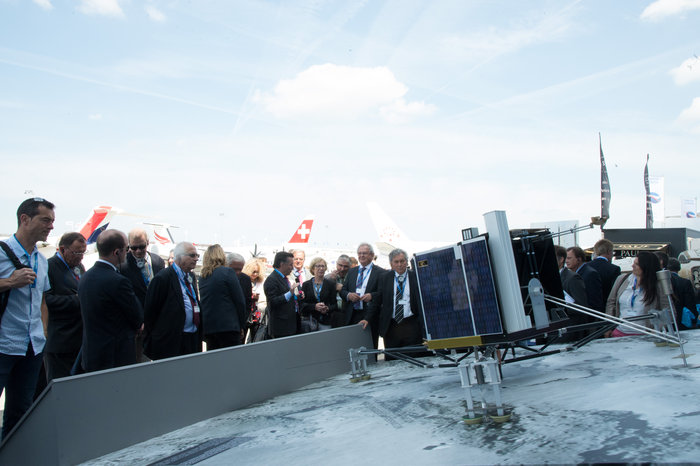
A model of the Philae lander on display at the ESA Pavilion at the Paris Air and Space Show this week. Credits: ESA–P. Sebirot, 2015
.
ESA is at the International Paris Air and Space Show, Le Bourget, this week. Tomorrow, Wednesday 17 June, a press briefing will be dedicated to the Rosetta Mission.
Members of the Rosetta and Philae teams will provide an update on the mission, present some of the latest results, and outline what still lies ahead.
Speakers include: Mark McCaughrean, Senior Science Adviser, ESA; Elsa Montagnon, Deputy Rosetta Flight Director, ESA; Philippe Gaudon, CNES Philae project manager, CNES; Jean-Pierre Bibring, Lead Lander Scientist, IAS Orsay. (Line up may be subject to change.)
.
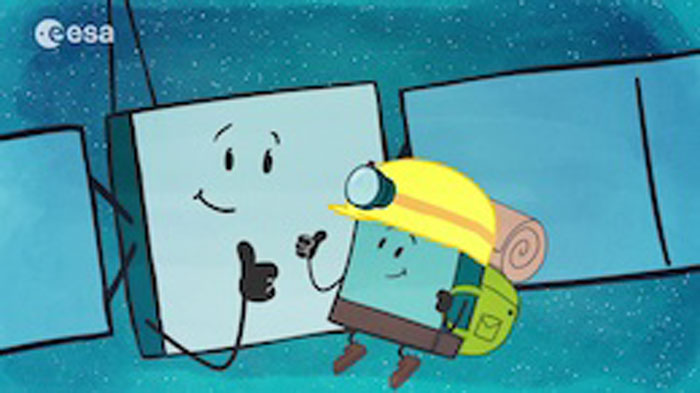
PREPARING ROSETTA TO LISTEN FOR LANDER
At the time of writing, the Rosetta orbiter has received no new signals from the Philae lander on the surface of Comet 67P/C-G since the last, very brief, signal receipt on the evening of 14 June.
This was expected, however, as the spacecraft was performing pre-planned science observations – involving either a spacecraft slew or off-pointing from the comet nucleus – throughout the two possible Philae-Rosetta daily communication slots.
On Monday 15 June, teams at ESA, DLR and CNES agreed to a new orbiter trajectory that will optimise the opportunities for lander-to-orbiter communication. This includes a change to nadir pointing (that is, pointing directly at the comet nucleus) during the daily communication slots, which will come into effect Wednesday morning, in line with the new trajectory change.
Rosetta's science investigations will also be adjusted to adapt to the new trajectory.
Commands to adjust the trajectory were successfully uploaded Monday evening; further commands will be uplinked on Thursday evening. The spacecraft will perform two manoeuvres, one on Wednesday morning and the second on Saturday morning. The effect of the two 'dog-leg' burns will be to bring the orbiter to a distance of 180 km from the comet and to reproduce the orbiter-comet geometry of the first contact.
This orbit lowering had been planned previously with the objective of flying as low as safely possible, since no star tracker problems have been detected while flying in the terminator plane at 200 km altitude. But now it also has the advantage of improving communication possibilities with Philae.
This morning, 16 June, the spacecraft was at about 224 km and moving out to about 235 km from the comet on its pre-planned trajectory. When Philae’s signal was first received on 13 June the spacecraft-comet separation was 200 km; by 14 June this was 206 km and the signal was weaker.
It is only once the orbiter is on the new trajectory, flying closer to the comet with nadir pointing in the latitudes of the lander that the communication possibilities will be improved.
Quelle: ESA
-
Update: 17.06.2015
.
COMETWATCH 7 JUNE
While the Rosetta and Philae teams are busy planning the next activities for the spacecraft and lander, CometWatch continues with a new view of Comet 67P/Churyumov-Gerasimenko captured on 7 June 2015, several days before Philae's wake-up call was received. This single frame NAVCAM image, taken at a distance of 203 km from the comet, has a resolution of 17.3 m/pixel and measures 17.8 km across.
-
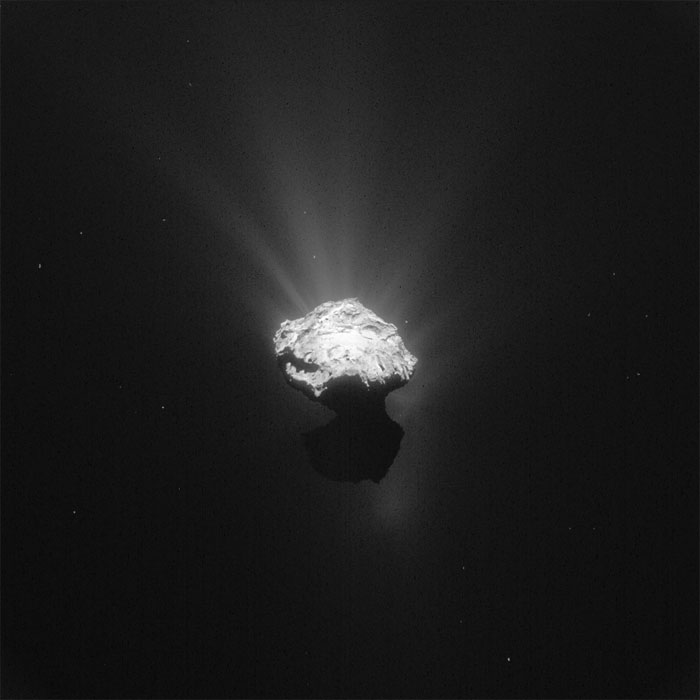
Single frame NAVCAM image of Comet 67P/C-G taken on 7 June 2015 from a distance of 203 km to the comet centre. Credits: ESA/Rosetta/NAVCAM – CC BY-SA IGO 3.0
.
The comet appears with the larger lobe up, its 'underside' gloriously illuminated. Familiar features of the Imhotep region are visible at the centre, as well as parts of Ash towards the top left. The elongated depression of Aten is partly cast in shadow and lies to to the lower left, with parts of Khepry to its right.
The image was processed to bring out the comet's activity, showing a multitude of jets – especially in the upper part of the image – but also the overall glow around the nucleus. Below the larger lobe, a beautifully delineated silhouette of the comet's neck and smaller lobe stands out against the diffuse material in the coma of 67P/C-G.
Another NAVCAM image of the comet, taken by Rosetta shortly before receiving Philae's signal on 13 June 2015, was published on Monday, alongside a status update on the operational aspects after the lander's historic wake-up. A press briefing with members of the Rosetta and Philae team took place this morning at 09:30 CEST at the International Paris Air and Space Show, Le Bourget, and the replay is available here.
The original 1024 x 1024 image of today's CometWatch is provided below:
.
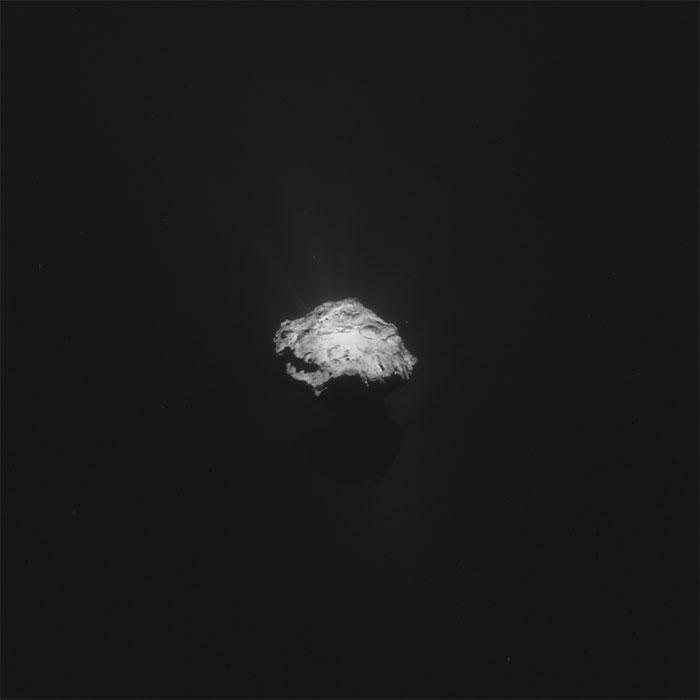
Quelle: ESA
-
Update: 18.06.2015
.
Unser Traum-Szenario für Philae - und Mission Finale für Rosetta
The Philae lander has woken up after a long hibernation on comet 67P/Churyumov–Gerasimenko. We spoke to the European Space Agency's operations manager, Cinzia Fantinati, about the drama of the probe's reactivation, what the next steps are for Philae, and how the Rosetta mothership will end its mission.

Fantinati: Philae's condition is "not too bad" (Image: DLR)
.
How are things at Rosetta mission control now?
It's a bit busy here, and the enthusiasm is immense. We were of course hoping for the Philae lander to wake up, but seeing it is great. We are really happy. The first data show that the status of the lander is not too bad.
Where were you last Saturday when you heard Philae had got back in touch?
As operations manager, I get the first call if we receive a signal from the lander. I was in Italy visiting my parents when I got a phone call at 11 at night from mission control in Darmstadt, saying we've got a signal.
How did you react?
When I saw the number displayed on my phone, I knew something must have happened, so I was really excited. My parents didn't really understand what was going on but they realised that Philae was calling home. They saw me running around, trying to phone my colleagues, connect computers.
I heard that the Philae lander manager, Stephan Ulamec, was in the pub when you called…
That's true. It took him at least an hour to notice I'd called. When he did, he also realised something big was happening – I don't usually call him in the middle of the night.
Philae bounced and ended up lost. Did you think it would come back to life?
We just didn't know. It could be that something had broken in the meantime, or gases pushing out from the warming comet could have blown Philae away, or blown dust on to its solar panels, rendering them useless – meaning no possibility of it switching back on.
So what did you hear from Philae?
The first contact was on Saturday, and it was very short – 85 seconds. On Sunday we got another contact that was longer – maybe 4 minutes – but was extremely unstable. At the moment the main concern is to stabilise and then optimise communication with Philae. It won't be easy.
Then what?
Then we want to explore the status of the lander: how much energy is available and how long is it operating per day. Once we know that we can start figuring out what to do with this energy.
In the last month we have prepared some initial basic operations of instruments that don't require any mechanical movement of the lander. We want to see how Philae is sitting on the comet before trying something that might compromise its stability. We might try using temperature sensors, comet dust measurements, or try to take some pictures. The cameras require quite a lot of energy to operate, so we have to be sure we have enough before we attempt that.
What pictures has Philae taken so far?
The last picture we got from Philae was in November, showing that around the lander were big walls of comet material. We've tried to locate the lander with the Rosetta probe's cameras. A week ago we released a picture showing that maybe it had been spotted but the resolution was not really high enough, so Philae appears as a little bright dot. That's not good enough to see how the lander is lying.
How far away is Rosetta from Philae?
At the moment of contact, the probe was 200 kilometres away, and we're now manoeuvring to get closer, to 180 kilometres. It will reach this distance on Friday.
What's your dream scenario for Philae?
Any science that can be done is a big success, but the dream would be to see the lander use its drill. That's the thing Philae can do that Rosetta cannot: taking a sample so that one of Philae's spectrometers can analyse it, and maybe the microscope can take a picture of it.
The lander also has more than 20 small ovens on a carousel. They heat the sample to release frozen gases for analysis. Each time the drill is used, it can take one sample and put it in one oven. Using the drill, oven and spectrometer would be energy-expensive, so we'll need to see what the energy budget looks like. Filling even one oven would be enough for me.
The comet comes closest to the sun on 13 August and then starts moving away, losing sunlight, so you're working against the clock…
Not just the clock. As the comet approaches the sun, the warming makes it more active, causing more outgassing and sending dust flying off it. What will happen to our two craft is unknown. The main problem is that as the comet gets more active, Rosetta has to move further away.
Why does Rosetta have to move away as 67P nears the sun?
The probe is able to navigate and position itself around the comet by monitoring stars using a star tracker. It has been confusing dust for stars, making navigation harder, and each time something like that happens, Rosetta must move away until navigation can safely resume. The main concern is that it would have to go so far away that communication with Philae could stop. Each day we try to get Rosetta closer to the comet, but the situation is changing day by day. It's a fight.
Quelle: D-News
-
Update: 19.06.2015
.
MIRO MAPS WATER IN COMET’S COMA
In a paper accepted for publication in the journal Astronomy & Astrophysics, the MIRO team present their first map of water vapour in the coma of Comet 67P/Churyumov-Gerasimenko.
.
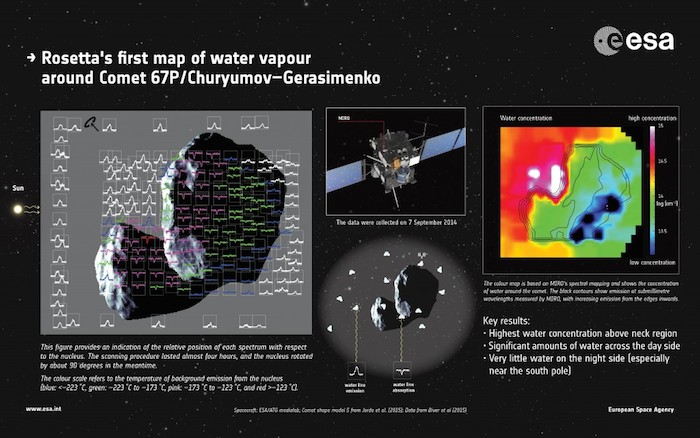
MIRO, the Microwave Instrument for the Rosetta Orbiter, first detected the emission from water molecules in the coma of Comet 67P/C-G on 6 June 2014, when Rosetta was 350,000 km from the comet, approximately equivalent to the distance of the Earth from the Moon. At the time, the comet was 3.9 AU – about 580 million km – from the Sun.
Since early July 2014, the MIRO team have been continuously monitoring water in the comet's environment, measuring its properties at different locations across the coma. Being in very close proximity to 67P/C-G, Rosetta, with the MIRO instrument on board, can 'dissect' the distribution of water and other molecules around the comet. Existing ground-based observatories and near-Earth space telescopes can at most get a global view of water in the outermost parts of a comet's coma.
As Rosetta approached the comet and MIRO could resolve the nucleus, the instrument was able to detect water in the coma by measuring the direct emission from water vapour in the coma and by observing absorption of radiation from the nucleus at water specific frequencies as the radiation passed through the coma.
.
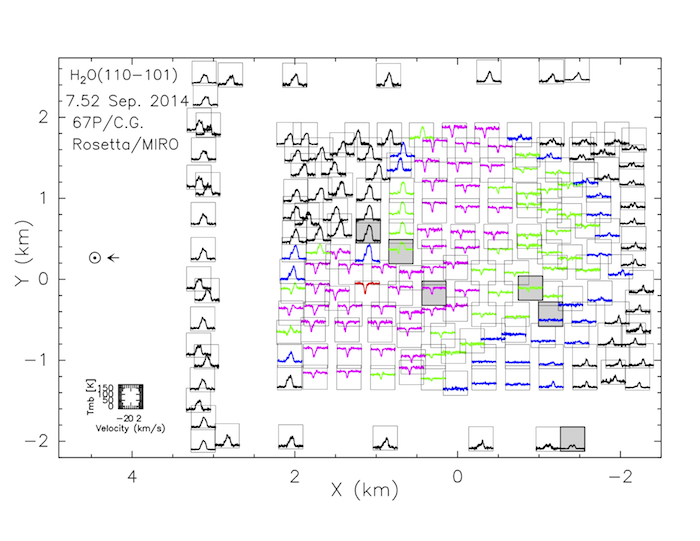
MIRO's spectral map of water at Comet 67P/C-G, obtained on 7 September 2014. From N. Biver et al. (2015)
.
On 7 September 2014, when Rosetta was 58 km from the comet centre, the MIRO team obtained their first map of the nucleus of 67P/C-G and its surroundings. Since MIRO is a single-pixel instrument, the scanning procedure took almost four hours, during which the nucleus had turned by about 90 degrees.
The map shows 201 spectra, covering the nucleus as well as parts of the coma around it. Each spectrum corresponds to the average of one to four nearby spectra, that were combined to obtain a higher signal-to-noise ratio.
The strongest signatures of water emission are observed in the off-nucleus spectra on the comet's day side; similarly, the strongest absorption features are seen in the spectra covering the day side of the nucleus. A few spectra sampling both coma and nucleus on the limb exhibit a combination of emission and absorption features.
.
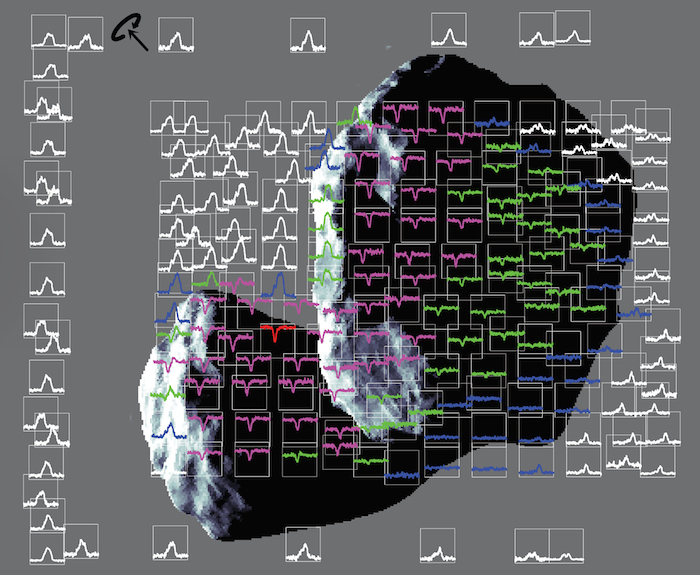
An indication of the position of each of MIRO's spectra with respect to the comet nucleus. The Sun is to the left. Data from Biver et al. (2015); the nucleus is represented according to the comet shape model 5 from Jorda et al. (2015)
.
Weak absorption was observed in the spectra covering the cool nucleus on the comet's night side, while only weak emission was detected over some of the coldest spots on the nucleus, with hardly any signs of water close to the south pole of 67P/C-G. The off-nucleus spectra on the night side also show weak emission lines from water in the coma.
This map was obtained using the spectral line of the H216O water molecule at a frequency of 556.936 GHz. An analogous, but coarser map was obtained using a much fainter spectral feature detected at a frequency of 547.676 GHz, characteristic of a different type of water molecule, H218O, which contains a heavy oxygen (18O) atom.
“Our observations show that the distribution of water in the coma is highly inhomogeneous,” explains Nicolas Biver, CNRS researcher at LESIA-Observatoire de Paris in Meudon, France, and lead author of the study.
.
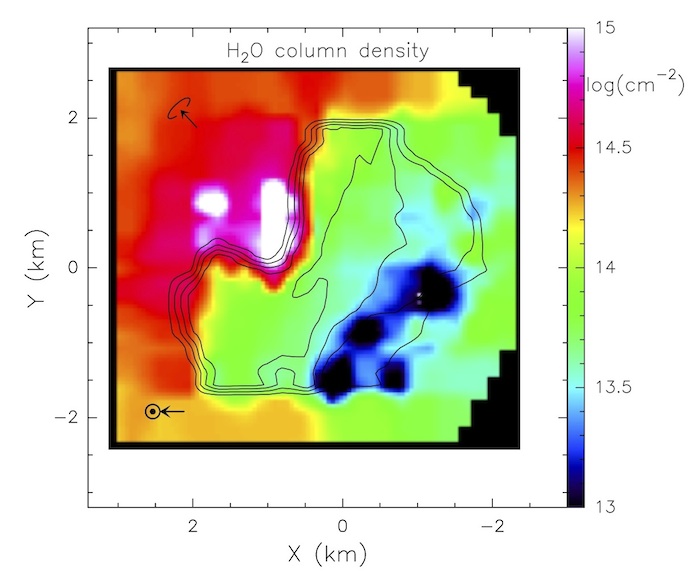
The column density of water around Comet 67P/C-G as measured by the MIRO instrument on Rosetta. From N. Biver et al. (2015)
.
“We found the highest density of water just above the neck, close to the north pole of the comet's rotation axis: in this narrow region, the column density of water is up to two orders of magnitude higher than elsewhere in the coma,” adds Dr Biver.
Lower but still substantial amounts of water are detected over the day side of the nucleus up to the terminator between the illuminated and dark side. The lowest amounts of water are found on the comet's night side – particularly over the southern polar regions; these could be due to either local outgassing or circulation effects within the coma, causing water to flow from the day to the night side.
Since last September, scientists in the MIRO team have obtained and are still analysing more maps of the distribution of water in the coma of 67P/C-G, as the comet is moving closer to the Sun.
Dr Sam Gulkis, Principal Investigator of MIRO, reports that the instrument is performing well, and observations of 67P/C-G are continuing daily as the comet approaches perihelion in August 2015.
MIRO: The MIRO instrument was built at the Jet Propulsion Laboratory, California Institute of Technology with contributions from LESIA and LERMA, Observatoire de Paris and the Max-Planck-Institut für Sonnensystemforschung. Funding was provided by the National Aeronautics and Space Administration, CNES and CNRS/INSU, and DLR and MPG.
---
ROSETTA TRACKS DEBRIS AROUND COMET
This blog post is based on the papers “Orbital elements of material surrounding comet 67P/Churyumov-Gerasimenko,” by B. Davidsson et al, and “Search for satellites near comet 67P/Churyumov-Gerasimenko using Rosetta/OSIRIS images,” by I. Bertini et al, which are both accepted for publication in Astronomy and Astrophysics.
Ever since its approach to and arrival at Comet 67P/Churyumov–Gerasimenko, Rosetta has been investigating the nucleus and its environment with a variety of instruments and techniques. One key area is the study of dust grains and other objects in the vicinity of the comet.
Earlier this year, an analysis of measurements from GIADA – Rosetta’s Grain Impact Analyzer and Dust Accumulator – and images from the OSIRIS camera revealed hundreds of individual grains, either bound to the comet's gravity or flowing away from it. These included small grains as well as much larger chunks, with sizes ranging from a few centimetres to two metres. Lumps up to four metres in size were also identified by NASA's EPOXI mission in the environment of Comet 103P/Hartley 2 after its flyby of this comet in 2010.
A new study based on OSIRIS images has now built on these previous detections of cometary chunks, using dedicated observations to perform a dynamical study and determine, for the first time, the orbits of four pieces of debris, the largest of them half a metre in size, in orbit around 67P/C-G.
“Previous studies were based on a handful of images of a given field, and this was sufficient to detect chunks of material and say that they are moving. However, to determine their trajectories and demonstrate whether they are truly bound to the comet, we need dozens of images taken over an extended period of time,” explains Björn Davidsson, an OSIRIS scientist at Uppsala University, Sweden, and lead author of the paper reporting the new results.
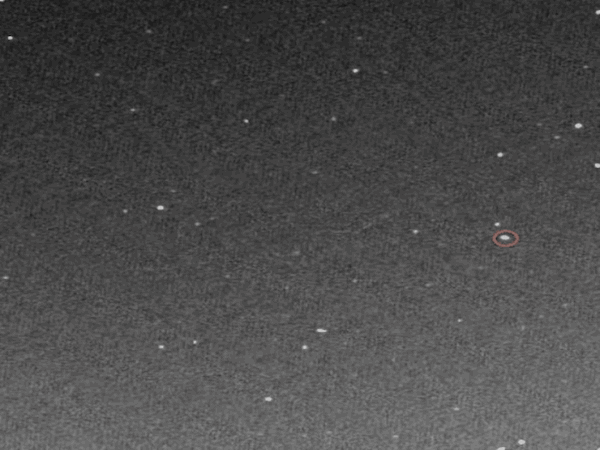 .
.
To follow the motion of the cometary debris in fine detail, the scientists monitored a patch of the sky with the OSIRIS wide-angle camera (WAC), which has a field of view of 12 x 12 degrees – over 700 times the area of the full Moon as seen from Earth. Observing over a thirty-minute interval on 10 September 2014, they obtained 30 images, one every minute, with an exposure of 10.2 seconds each.
Incidentally, these observations were performed just a few hours before the manoeuvre that would place the spacecraft on its first bound orbit around the comet. At that time, Rosetta was 30 km away from the comet centre.
When Davidsson and his collaborators later inspected the images, they identified four debris pieces with sizes ranging between 15 and 50 centimetres, making their way against the stellar background in the sequence of images. The chunks appear to move very slowly, with velocities of a few tens of centimetres per second, and are within four to 17 kilometres of the comet.
“This is the first time that we could determine the individual orbits of such pieces of debris around a comet. This information is very important to study their origin, and is helping us understand the mass loss processes of comets,” says Davidsson.
It seems that some of these chunks may have been accompanying the nucleus of 67P/C-G for quite a while.
In fact, three of these pieces appeared to be bound to the comet's gravity, moving on elliptical orbits, in agreement with what the scientists had expected. However, the paths covered by the grains over the 30-minute long monitoring were too short to enable a unique determination of their orbits, so they cannot exclude that these three chunks are in fact on unbound, hyperbolic orbits.
As for their origin, the chunks might date back to the last time that the comet reached its closest point to the Sun, the perihelion passage in 2009, when they were driven away from the nucleus by very strong sublimation processes. But since the gas drag was not sufficient to free them from the gravity of the nucleus, they lingered in the realm of the comet rather than dispersing into space.
“This study proves that comets can eject such large chunks of material and that these may also remain bound for long stretches of time as the comet swings around the Sun,” says Davidsson.
On the other hand, one of the pieces of debris is definitely following a hyperbolic trajectory, which will see it soon depart from the comet's surroundings.
.
 .
.The trajectory of the outbound chunk (identified with the letter 'B' in the paper) found around Comet 67P/C-G. The chunk is seen moving against the background of fixed stars. This sequence shows ten consecutive images taken with the OSIRIS wide-angle camera (WAC) on 10 September 2014.
The images span 1.9 x 2.1 degrees, showing a portion of the full WAC field of view. Each image was taken with an exposure of 10.2 seconds, with 60 seconds between the beginning of each exposure. Transient point sources are also visible, likely due to cosmic rays, while the long streaks visible in certain frames are caused by dust grains that happened to be close to Rosetta during the exposure.
Credit: ESA/Rosetta/MPS for OSIRIS Team MPS/UPD/LAM/IAA/SSO/INTA/UPM/DASP/IDA
“The outbound trajectory of the fourth lump was a surprise: it suggests that the cloud of debris these objects belong to, bound to the comet since its last perihelion, had already started to dissolve in September 2014, when the comet was 3.4 AU (about 500 million km) from the Sun,” he adds.
This is likely the result of increased activity, causing outgassing from the nucleus and pushing the chunk away from the comet's gravity.
One of the three bound lumps also has an interesting trajectory that appears to cross the comet's nucleus, hinting that it might have been ejected shortly before the observations.
This possibility is as intriguing as it is puzzling, since the comet was still at a very large distance from the Sun at the time for sunlight to cause enough sublimation and release such a large chunk of material from the nucleus surface.
More sets of similar images were collected after last September, and they are being analysed to identify and study the trajectories of other chunks as the comet got closer and closer to the Sun. However, it will be virtually impossible to recover and identify the same chunks in later images.
As far as Rosetta is concerned, the lumps of cometary material detected by Davidsson and colleagues are too sparse to pose any hazard to the spacecraft operations.
But what about much larger lumps of cometary material, several tens of metres across? Such satellites have been detected around many asteroids and other small bodies in the solar system. Is there any evidence for similar ‘companions’ of Comet 67P/C-G?
Ivano Bertini from the University of Padua, Italy, led a study to look for such satellites around the comet, reporting their results in another paper tto be published in Astronomy and Astrophysics. The team used images that were taken with the OSIRIS narrow-aperture camera (NAC) in July 2014, prior to arrival at the comet, to inspect the comet's large-scale surroundings at high resolution.
After careful examination of these images, the scientists found no evidence of satellites around 67P/C-G. The upper limits set by these measurements indicate that no chunks larger than six metres were found within distances of 20 kilometres from the nucleus, and none larger than a metre at distances between 20 and 110 kilometres from the nucleus.
Finding such a large satellite around the comet could have brought additional information to constrain the formation of this curiously shaped body. However, the analysis of Bertini and collaborators does not exclude the possibility that 67P/C-G might have had such a companion in the past, that could have well been lost given the harsh events that characterise a comet's life.
Quelle: ESA
OSIRIS: The scientific imaging system OSIRIS was built by a consortium led by the Max Planck Institute for Solar System Research (Germany) in collaboration with CISAS, University of Padova (Italy), the Laboratoire d'Astrophysique de Marseille (France), the Instituto de Astrofísica de Andalucia, CSIC (Spain), the Scientific Support Office of the European Space Agency (The Netherlands), the Instituto Nacional de Técnica Aeroespacial (Spain), the Universidad Politéchnica de Madrid (Spain), the Department of Physics and Astronomy of Uppsala University (Sweden), and the Institute of Computer and Network Engineering of the TU Braunschweig (Germany). OSIRIS was financially supported by the national funding agencies of Germany (DLR), France (CNES), Italy (ASI), Spain (MEC), and Sweden (SNSB), and the ESA Technical Directorate.
Quelle: ESA
-
Update: 22.06.2015
.
ROSETTA AND PHILAE IN CONTACT AGAIN
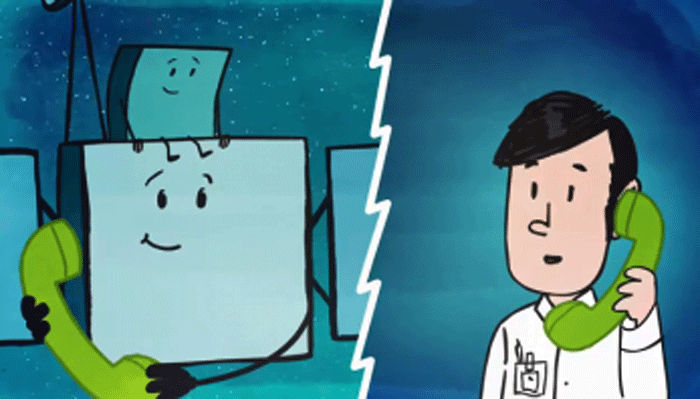
ESA and its Rosetta mission partners have confirmed that another communication link has been made between Rosetta and Philae today.
The signal was transmitted from Rosetta to ESA’s space operations centre in Darmstadt and received at 15:37 CEST on 19 June, and confirmed by the Lander Control Centre at the German Space Centre, DLR. A second signal was received at 15:54 CEST.
The downlink was stable; the two contacts received by Rosetta lasted two minutes each. Both delivered numerous packets of lander housekeeping and status data, 185 in total, which are still being analysed at the time of this writing. No science data were anticipated or received.
“We are very happy to have received signals from the lander again, and we are all working hard towards establishing a robust link between Rosetta and Philae,” comments Patrick Martin, ESA Rosetta mission manager.
This was the first signal received from Philae since 14 June. This was not unexpected, however, due to the pre-planned science operations of the orbiter, and its location around 180 km above the comet’s surface today.
In the meantime, new commands have been uploaded to Rosetta to further adjust its trajectory and distance from the comet to improve the radio visibility between the two spacecraft, with the first sets of thruster burns having taken place this past Wednesday and the next set planned for Saturday morning. The goal is to bring Rosetta to about 177 km from the comet nucleus and keep it in a range of latitudes that maximise opportunities for lander communication.
The Rosetta and Philae teams will be closely monitoring subsequent transmissions between the spacecraft, not only to better determine the health of the lander, but also to understand the length and frequency of available communication timeslots. This information is needed to determine when to upload new commands in order to restart science operations and, similarly, when the data can be downloaded.
---
COMETWATCH 14 JUNE
Today's CometWatch entry is a single frame NAVCAM image taken on 14 June, when Rosetta was 203 km from the centre of Comet 67P/Churyumov-Gerasimenko. The resolution is 17.3 m/pixel and the image measures 17.7 km across.
.
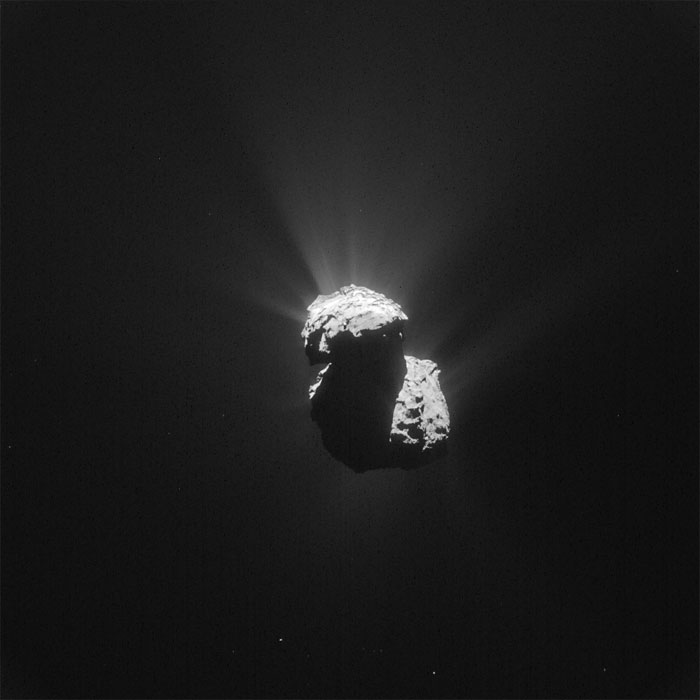
NAVCAM image of Comet 67P/C-G taken on 14 June 2015 from a distance of 203 km to the comet centre. Credits: ESA/Rosetta/NAVCAM – CC BY-SA IGO 3.0
.
The image was processed in LightRoom to enhance the activity of 67P/C-G, resulting in a powerful juxtaposition of contrasts. Pointing upwards, the small comet lobe shows the narrow and bouldered regions of Serqet and Nut, along with some parts of Ma'at and Maftet. A hint of the large Hatmehit depression can also be seen towards the top left, its outer rim nicely framed by outflowing material in the background.
Anuket and Hapi, on the comet's neck, are cast in the shadow of the small lobe. Parts of the large lobe are also hidden in the shadows, while the illuminated portion reveals some of the circular features of the Seth region and, to their right, the smoother terrains of Anubis, punctuated with a few boulders.
In the lower part of the image, the dark portions of the large lobe stand out against the brighter background of the coma. Interestingly, this can be seen also in the original (unprocessed) 1024 x 1024 image, which is provided below:
.
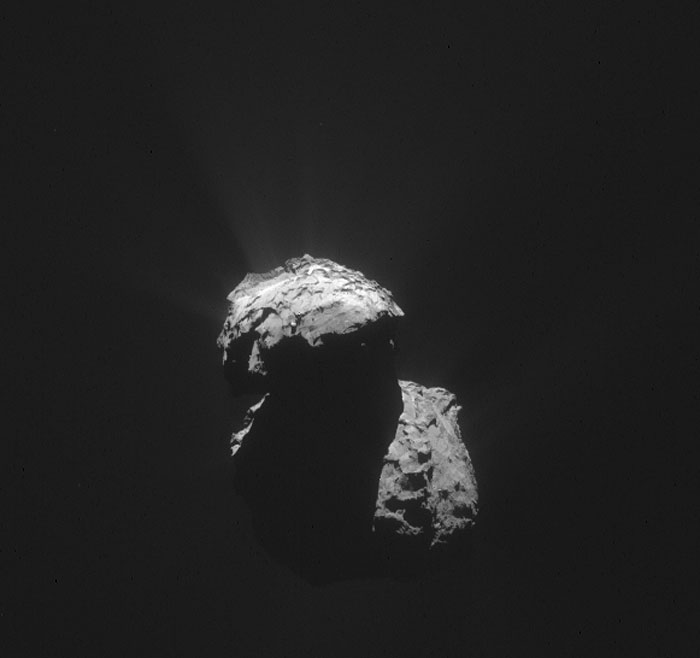
Quelle: ESA
-
Update: 23.06.2015
.
ROSETTA MISSION EXTENDED
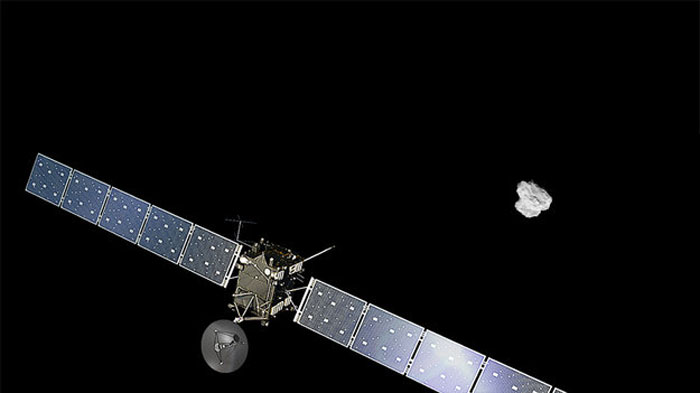
The adventure continues: ESA today confirmed that its Rosetta mission will be extended until the end of September 2016, at which point the spacecraft will most likely be landed on the surface of Comet 67P/Churyumov-Gerasimenko.
Rosetta was launched in 2004 and arrived at the comet in August 2014, where it has been studying the nucleus and its environment as the comet moves along its 6.5-year orbit closer to the Sun. After a detailed survey, Rosetta deployed the lander, Philae, to the surface on 12 November. Philae fell into hibernation after 57 hours of initial scientific operations, but recently awoke and made contact with Rosetta again.
Rosetta’s nominal mission was originally funded until the end of December 2015, but at a meeting today, ESA’s Science Programme Committee has given formal approval to continue the mission for an additional nine months. At that point, as the comet moves far away from the Sun again, there will no longer be enough solar power to run Rosetta’s set of scientific instrumentation efficiently.
“This is fantastic news for science,” says Matt Taylor, ESA’s Rosetta Project Scientist. “We’ll be able to monitor the decline in the comet’s activity as we move away from the Sun again, and we’ll have the opportunity to fly closer to the comet to continue collecting more unique data. By comparing detailed ‘before and after’ data, we’ll have a much better understanding of how comets evolve during their lifetimes.”
Comet 67P/Churyumov-Gerasimenko will make its closest approach to the Sun on 13 August and Rosetta has been watching its activity increase over the last year. Continuing its study of the comet in the year following perihelion will give scientists a fuller picture of how a comet’s activity waxes and wanes along its orbit.
The extra observations collected by Rosetta will also provide additional context for complementary Earth-based observations of the comet. At present, the comet is close to the line-of-sight to the Sun, making ground-based observations difficult.
As the activity diminishes post-perihelion, it should be possible to move the orbiter much closer to the comet’s nucleus again, to make a detailed survey of changes in the comet’s properties during its brief ‘summer’.
In addition, there may be an opportunity to make a definitive visual identification of Philae. Although candidates have been seen in images acquired from a distance of 20 km, images taken from 10 km or less after perihelion could provide the most compelling confirmation.
During the extended mission, the team will use the experience gained in operating Rosetta in the challenging cometary environment to carry out some new and potentially slightly riskier investigations, including flights across the night-side of the comet to observe the plasma, dust, and gas interactions in this region, and to collect dust samples ejected close to the nucleus.
As the comet recedes from the Sun, the solar-powered spacecraft will no longer receive enough sunlight to operate efficiently and safely, equivalent to the situation in June 2011 when the spacecraft was put into hibernation for 31 months for the most distant leg of its journey out towards the orbit of Jupiter.
In addition, Rosetta and the comet will again be close to the Sun as seen from the Earth in October 2016, making operations difficult by then.
However, with Rosetta’s propellant largely depleted by that time, it makes little sense to place the spacecraft in hibernation again.
“This time, as we’re riding along next to the comet, the most logical way to end the mission is to set Rosetta down on the surface,” says Patrick Martin, Rosetta Mission Manager.
“But there is still a lot to do to confirm that this end-of-mission scenario is possible. We’ll first have to see what the status of the spacecraft is after perihelion and how well it is performing close to the comet, and later we will have to try and determine where on the surface we can have a touchdown.”
If this proposed scenario were played out, then the spacecraft would be commanded to spiral down to the comet over a period of about three months.
It is expected that science operations would continue throughout this period and be feasible up to very close to the end of mission, allowing Rosetta’s instruments to gather unique data at unprecedentedly close distances.
Once the orbiter lands on the surface, however, it is highly unlikely to be able to continue operations and relay data back to Earth, bringing to an end one of the most successful space exploration missions of all time.
Quelle: ESA
-
Update: 24.06.2015
.
COMETWATCH 15 JUNE
Today's CometWatch entry is a single frame NAVCAM image taken on 15 June, when Rosetta was 207 km from the centre of Comet 67P/Churyumov-Gerasimenko. The resolution is 17.7 m/pixel and the image measures 18.1 km across.
.
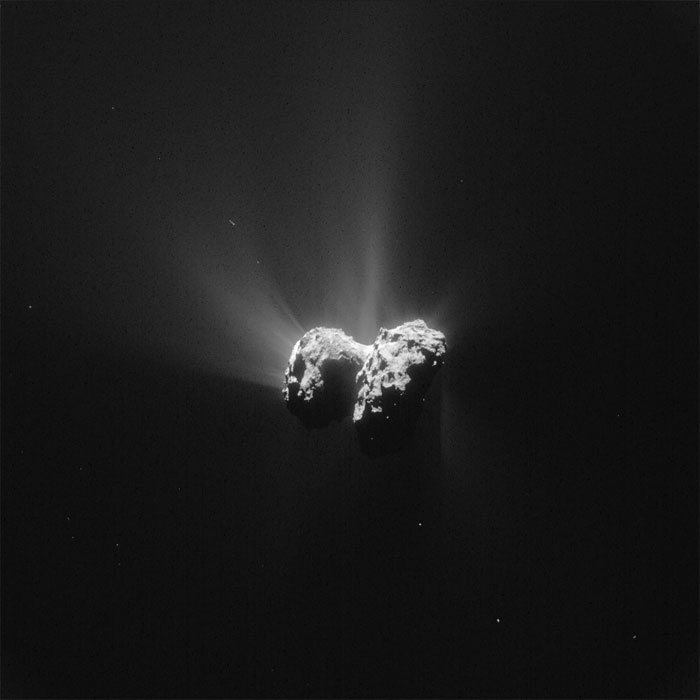
Processed NAVCAM image of Comet 67P/C-G taken on 15 June 2015. Credits: ESA/Rosetta/NAVCAM – CC BY-SA IGO 3.0
The image is processed to bring out the details of the comet’s activity and to highlight the shadows and silhouettes of its two lobes, which in this orientation shows the small lobe to the left and the large lobe to the right.
The original 1024 x 1024 pixel image is provided below:
.
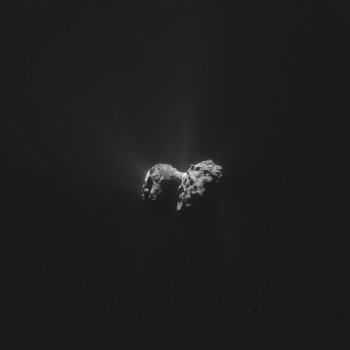
---
EXPOSED WATER ICE DETECTED ON COMET’S SURFACE
This article is mirrored from the main ESA web portal and covers the results published in a new paper in the journal Astronomy & Astrophysics titled "OSIRIS observations of metre-size exposures of H2O ice at the surface of 67P/Churyumov-Gerasimenko and interpretation using laboratory experiments," by Antoine Pommerol et al.
.
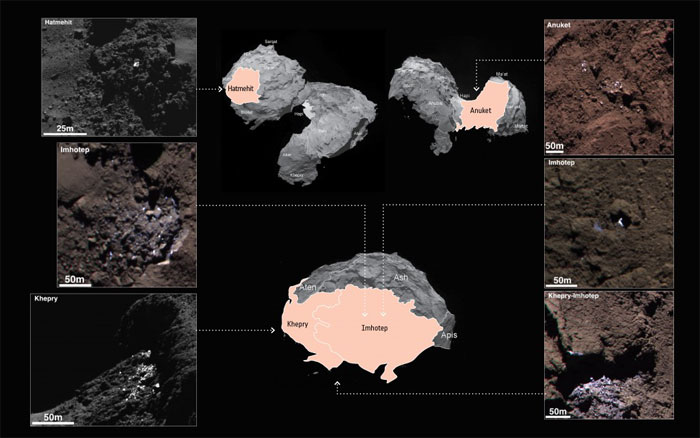
Examples of six different bright patches identified on the surface of Comet 67P/Churyumov-Gerasimenko in OSIRIS narrow-angle camera images acquired in September 2014. The insets point to the broad regions in which they were discovered (not to specific locations). In total, 120 bright regions, including clusters of bright features, isolated features and individual boulders, were identified in images acquired during September 2014 when the spacecraft was between 20-50 km from the comet centre.
On the left hand side of the image a boulder with icy patches in Hatmehit (top) a cluster of icy features in Imhotep (middle) and a cluster in Khepry (bottom) is presented; on the right hand side a cluster in Anuket (top), a bright feature in Imhotep and a cluster close to the Khepry-Imhotep boundary (bottom) is shown. The false colour images are red-green-blue composites assembled from monochrome images taken at different times and have been stretched and slightly saturated to emphasis the contrasts of colour such that dark terrains appear redder and bright regions appear significantly bluer compared with what the human eye would normally see. This imaging technique allows scientists to determine more about the nature of the material; in this case the bluer colour indicates the presence of ice.
Credits: ESA/Rosetta/MPS for OSIRIS Team MPS/UPD/LAM/IAA/SSO/INTA/UPM/DASP/IDA
Using the high-resolution science camera on board ESA’s Rosetta spacecraft, scientists have identified more than a hundred patches of water ice a few metres in size on the surface of Comet 67P/Churyumov-Gerasimenko.
Rosetta arrived at the comet in August 2014 at a distance of about 100 km and eventually orbited the comet at 10 km or less, allowing high-resolution images of the surface to be acquired.
A new study just published in the journal Astronomy & Astrophysics focuses on an analysis of bright patches of exposed ice on the comet’s surface.
Based on observations of the gas emerging from comets, they are known to be rich in ices. As they move closer to the Sun along their orbits, their surfaces are warmed and the ices sublimate into gas, which streams away from the nucleus, dragging along dust particles embedded in the ice to form the coma and tail.
But some of the comet’s dust also remains on the surface as the ice below sublimates, or falls back on to the nucleus elsewhere, coating it with a thin layer of dusty material and leaving very little ice directly exposed on the surface. These processes help to explain why Comet 67P/Churyumov-Gerasimenko and other comets seen in previous flyby missions are so dark.
Despite this, Rosetta’s suite of instruments has already detected a variety of gases, including water vapour, carbon dioxide and carbon monoxide, thought to originate from frozen reservoirs below the surface.
.
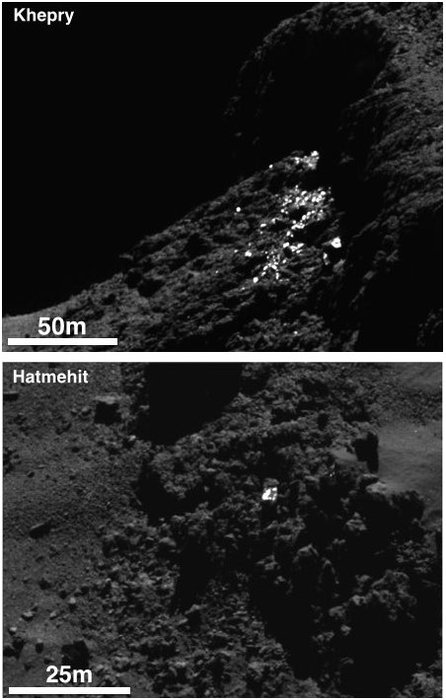
Example of a cluster of bright spots on Comet 67P/Churyumov-Gerasimenko found in the Khepry region (top) and an individual boulder with bright patches on its surface in the Hatmehit region (bottom). The bright patches are thought to be exposures of water-ice.
Both images shown here are subsets of OSIRIS narrow-angle camera images taken on 30 September, when the spacecraft was about 20 km from the comet centre.
Credits: ESA/Rosetta/MPS for OSIRIS Team
.
Now, using images taken with Rosetta’s OSIRIS narrow-angle camera last September, scientists have identified 120 regions on the surface of Comet 67P/Churyumov-Gerasimenko that are up to ten times brighter than the average surface brightness.
Some of these bright features are found in clusters, while others appear isolated, and when observed at high resolution, many of them appear to be boulders displaying bright patches on their surfaces.
The clusters of bright features, comprising a few tens of metre-sized boulders spread over several tens of metres, are typically found in debris fields at the base of cliffs. They are most likely the result of recent erosion or collapse of the cliff wall revealing fresher material from below the dust-covered surface.
By contrast, some of the isolated bright objects are found in regions without any apparent relation to the surrounding terrain. These are thought to be objects lifted up from elsewhere on the comet during a period of cometary activity, but with insufficient velocity to escape the gravitational pull of the comet completely.
In all cases, however, the bright patches were found in areas that receive relatively little solar energy, such as in the shadow of a cliff, and no significant changes were observed between images taken over a period of about a month. Furthermore, they were found to be bluer in colour at visible wavelengths compared with the redder background, consistent with an icy component.
“Water ice is the most plausible explanation for the occurrence and properties of these features,” says Antoine Pommerol of the University of Bern and lead author of the study.
.
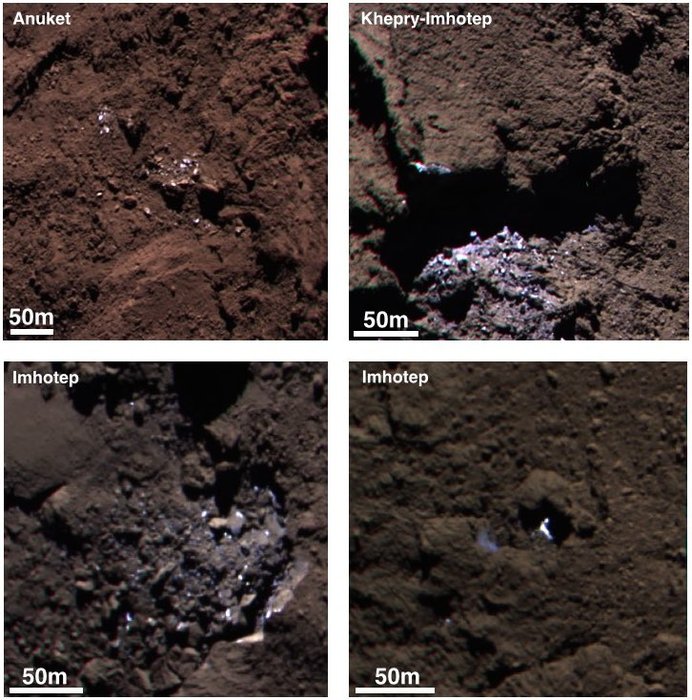
Examples of icy bright patches seen on Comet 67P/Churyumov-Gerasimenko during September 2014. The two left hand images are subsets of OSIRIS narrow-angle camera images acquired on 5 September; the right hand images were acquired on 16 September. During this time the spacecraft was about 30-40 km from the comet centre. The images are false colour red-green-blue composites assembled from monochrome images acquired at different times with the 882.1nm (red), 649.2nm (green) and 360.0nm (blue) channels. Each channel was stretched and slightly saturated to emphasis the contrasts of colour across the scene such that dark terrains appear redder and bright regions appear significantly bluer compared with what a human eye would normally see.
While various ices mixed with dust would be consistent with the blue signature, taken with other observations, the various properties of the bright patches point to water-ice.
Credits: ESA/Rosetta/MPS for OSIRIS Team
.
“At the time of our observations, the comet was far enough from the Sun such that the rate at which water ice would sublimate would have been less than 1 mm per hour of incident solar energy. By contrast, if carbon dioxide or carbon monoxide ice had been exposed, it would have rapidly sublimated when illuminated by the same amount of sunlight. Thus we would not expect to see that type of ice stable on the surface at this time.”
The team also turned to laboratory experiments that tested the behaviour of water ice mixed with different minerals under simulated solar illumination in order to gain more insights into the process. They found that after a few hours of sublimation, a dark dust mantle a few millimetres thick was formed. In some places this acted to completely conceal any visible traces of the ice below, but occasionally larger dust grains or chunks would lift from the surface and move elsewhere, exposing bright patches of water ice.
“A 1 mm thick layer of dark dust is sufficient to hide the layers below from optical instruments,” confirms Holger Sierks, OSIRIS principal investigator at the Max Planck Institute for Solar System Research in Göttingen.
“The relatively homogeneous dark surface of the nucleus of Comet 67P/Churyumov-Gerasimenko, only punctuated by some metre-scale bright dots, can be explained by the presence of a thin dust mantle composed of refractory mineral and organic matter, with the bright spots corresponding to areas from which the dust mantle was removed, revealing a water-ice-rich subsurface below.”
The team also speculates about the timing of the formation of the icy patches. One hypothesis is that they were formed at the time of the last closest approach of the comet to the Sun, 6.5 years ago, with icy blocks ejected into permanently shadowed regions, preserving them for several years below the peak temperature needed for sublimation.
Another idea is that even at relatively large distances from the Sun, carbon dioxide and carbon monoxide driven-activity could eject the icy blocks. In this scenario, it is assumed that the temperature was not yet high enough for water sublimation, such that the water-ice-rich components outlive any exposed carbon dioxide or carbon monoxide ice.
“As the comet continues to approach perihelion, the increase in solar illumination onto the bright patches that were once in shadow should cause changes in their appearance, and we may expect to see new and even larger regions of exposed ice,” says Matt Taylor, ESA’s Rosetta project scientist.
“Combining OSIRIS observations made pre- and post-perihelion with other instruments will provide valuable insight into what drives the formation and evolution of such regions.”
More information can be found in the paper, which is available to read online in Astronomy & Astrophysics, here.
The individual images making up the context images presented in this release are also provided below. All images credit: ESA/Rosetta/MPS for OSIRIS Team MPS/UPD/LAM/IAA/SSO/INTA/UPM/DASP/IDA
About OSIRIS
The scientific imaging system OSIRIS was built by a consortium led by the Max Planck Institute for Solar System Research (Germany) in collaboration with CISAS, University of Padova (Italy), the Laboratoire d'Astrophysique de Marseille (France), the Instituto de Astrofísica de Andalucia, CSIC (Spain), the Scientific Support Office of the European Space Agency (The Netherlands), the Instituto Nacional de Técnica Aeroespacial (Spain), the Universidad Politéchnica de Madrid (Spain), the Department of Physics and Astronomy of Uppsala University (Sweden), and the Institute of Computer and Network Engineering of the TU Braunschweig (Germany). OSIRIS was financially supported by the national funding agencies of Germany (DLR), France (CNES), Italy (ASI), Spain (MEC), and Sweden (SNSB) and the ESA Technical Directorate.
Quelle: ESA
.
Update: 26.06.2015
.
ROSETTA AND PHILAE: SEARCHING FOR A GOOD SIGNAL
After seven months in hibernation on the surface of Comet 67P/Churyumov-Gerasimenko, Rosetta’s lander Philae communicated with Earth via the orbiter on 13 June. Since then, seven periods of connection have been confirmed between the orbiter and lander, but all have been intermittent. One of the key issues being worked on is to adjust Rosetta’s trajectory to see whether a more reliable communications link can be established with Philae. This report describes the status of those efforts as of 26 June, and has been prepared with inputs from ESA’s Rosetta Science Ground Segment team at ESAC and the flight control team at ESOC, along with the Lander Control Centre at DLR.
.
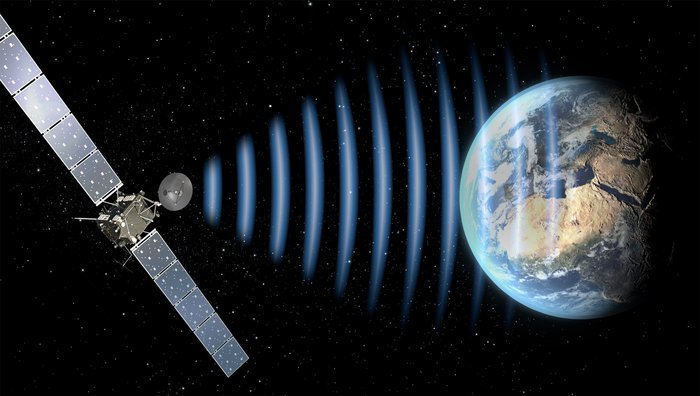
When have contacts been made?
Confirmed contacts between Rosetta and Philae have been made on 13, 14, 19, 20, 21, 23, and 24 June, but were intermittent during those contact periods. For example, the contact on 19 June was stable but split into two short periods of two minutes each. Conversely, the contact on 24 June started at 17:20 UT (on board Rosetta) and ran for 20 minutes, but the quality of the link was very patchy and only about 80 packets of telemetry were received. Prior to this, on Tuesday, 23 June, there was a 20-second contact, but no stable link was established and consequently no telemetry data were received.
How frequently do Rosetta and Philae try to make contact?
Comet 67P/C-G rotates with a 12.4 hour period and thus Philae’s location is not always visible to Rosetta. Roughly speaking, there are two opportunities for contact between the two spacecraft each Earth day, but their duration depends on the orientation of the transmitting antenna on Philae and the location of Rosetta along its trajectory around the comet. Similarly, as the comet rotates, Philae is not always in sunlight and thus not always generating enough power via its solar panels to receive and transmit signals. At the moment, the predicted contact windows vary between a few tens of minutes and up to three hours. During these contact windows, the ideal situation would be that a powered-up Philae hears Rosetta’s calling signal and responds by establishing a link back to the orbiter, then transmitting the data stored on-board via that link.
Why do we care about a stable connection?
Data are stored in two mass memories on-board Philae, and in order to download the data in the most efficient way possible, a stable ‘call’ duration of about 50 minutes is desired. It can take around 20 minutes for the data to be dumped from each one to the Rosetta orbiter, and additional time is needed to confirm that a stable link has been acquired in the first place, and also for uploading new commands.
Can the lander still be operated with short communications links?
Yes, but this situation is not ideal because it has an impact on the overall time available to perform scientific operations in the long term. That’s because each time a new science sequence was initiated, it would take longer to get the accumulated science data back and free up on-board storage before new commands could be uploaded and subsequently executed.
What might be affecting the link from the lander’s point of view?
A number of factors regarding the lander’s current status may contribute to the quality of the communications links observed so far. These include:
Lander power availability: the orbiter needs to be flying overhead the lander’s position when the lander is ‘awake’, that is, when it is generating enough power to have its receivers and transmitter switched on.
Lander location and orientation: the orientation of the lander on the surface of the comet determines how its antenna pattern is projected into space, and the rugged topography immediately surrounding Philae can also distort that antenna pattern.
Lander health status: errors in the various on-board units could also affect the chances of making a stable link.
What might be affecting the link from the orbiter’s point of view?
Equivalently, there are a number of parameters related to the orbiter that could be influencing the quality of the communications link observed so far:
Distance to the comet: the strength of the signal received by the orbiter diminishes as the square of the distance between the orbiter and the lander, and thus the chances of a stable link are reduced if Rosetta is too far from the comet.
Trajectory of the orbiter: to make a link, the antenna pattern of the lander must overlap with that of the orbiter, and given the constraints set by the lander antenna pattern, certain trajectories of the orbiter around the comet will be more effective at seeing a ‘clean’ lander signal than others.
Pointing of the orbiter: the exact orientation of the orbiter in space plays a role, because if the dedicated, non-steerable antenna used to communicate with the lander is not pointed directly at the comet, the strength of the signal received from the lander will be reduced. Some science observations being made by Rosetta require the orbiter to be pointed off the nucleus, but steps are being taken to avoid that situation during potential contacts with Philae.
Can any of these factors be changed?
Until a stable link is achieved between the orbiter and the lander and new commands uploaded, it is obviously not possible to try and ‘tune’ the parameters on-board the lander. Thus, present efforts are focused on improving the factors related to the orbiter. However, this is not straightforward, as the spacecraft operations team must keep the safety of the orbiter as their highest priority at a time when the comet is becoming more and more active.
How close can Rosetta get to the comet and still remain safe?
In order to navigate around the comet, Rosetta uses its star trackers to determine its orientation in space, and thus keep its instruments and high gain antenna pointed in the right directions. However, in the dusty environment of a comet, individual dust particles can mimic stars, making it difficult for the star trackers to operate effectively. If the star trackers are unable to determine the spacecraft’s orientation, it will go into safe mode, as experienced during one of the March close fly-bys of the comet. In the worst case, contact with Earth may be lost, which would lead to the spacecraft entering an autonomous mode that could take days or weeks to recover from.
The increasingly-active environment of Comet 67P/C-G is proving to be dustier than planned for when Rosetta was built and thus since March, the spacecraft has been flying at safer distances of roughly 200 km from the comet to avoid similar issues occurring. It has also been moved into a so-called ‘terminator trajectory’ around the comet, also aimed at reducing the impact of the dusty environment on the star trackers.
The spacecraft operations team are slowly edging Rosetta closer to the comet in this terminator trajectory, closely monitoring the performance of the star trackers in ‘continuous tracking mode’, and planning the trajectory for the days ahead. At the moment, Rosetta is following a trajectory scheme that allows it to come as close as 165 km from the comet, and there are signs that dust interference is becoming an issue again. A manoeuvre planned for Saturday morning will move the spacecraft to 160 km by 30 June and the team will assess the star tracker performance at that time in order to determine if even closer orbits are possible, or if Rosetta needs to be moved further away again.
How is the trajectory being changed?
The current terminator trajectory of Rosetta has it flying over the boundary between comet day and night. The main change that can be made within this scheme is to the latitude of the ground track of the orbit on the surface of the comet. This is currently being stepped down from +55 degrees (on 24 June) to –8 degrees (on 26 June), with a better quality signal between Rosetta and Philae being detected at lower latitudes. For comparison, just after landing in November 2014, Rosetta was flying over latitudes of +15 to +25 degrees. In the coming week, the latitudes will slowly be stepped back up again from –8 to +50 degrees, with a careful assessment being made of signal strength at low latitudes again.
How long is it going to take to resolve the situation?
This is a very dynamic, real-time process, and thus it is hard to predict when a stable link might be made between Rosetta and Philae. The mission teams are working on a short-term trajectory planning schedule, which is updated every Monday and Thursday morning. Changes to Rosetta’s trajectory are made depending on the latest information with regards lander communications and the performance of the orbiter’s star trackers in the days between each decision point. In addition, representatives from ESA’s Rosetta team, the Lander Control Centre at DLR in Cologne, and the Lander Science Operations and Navigation Centre at CNES, Toulouse discuss daily the latest status of any lander communication events.
We will keep you posted as further information becomes available.
Quelle: ESA
.
4376 Views
